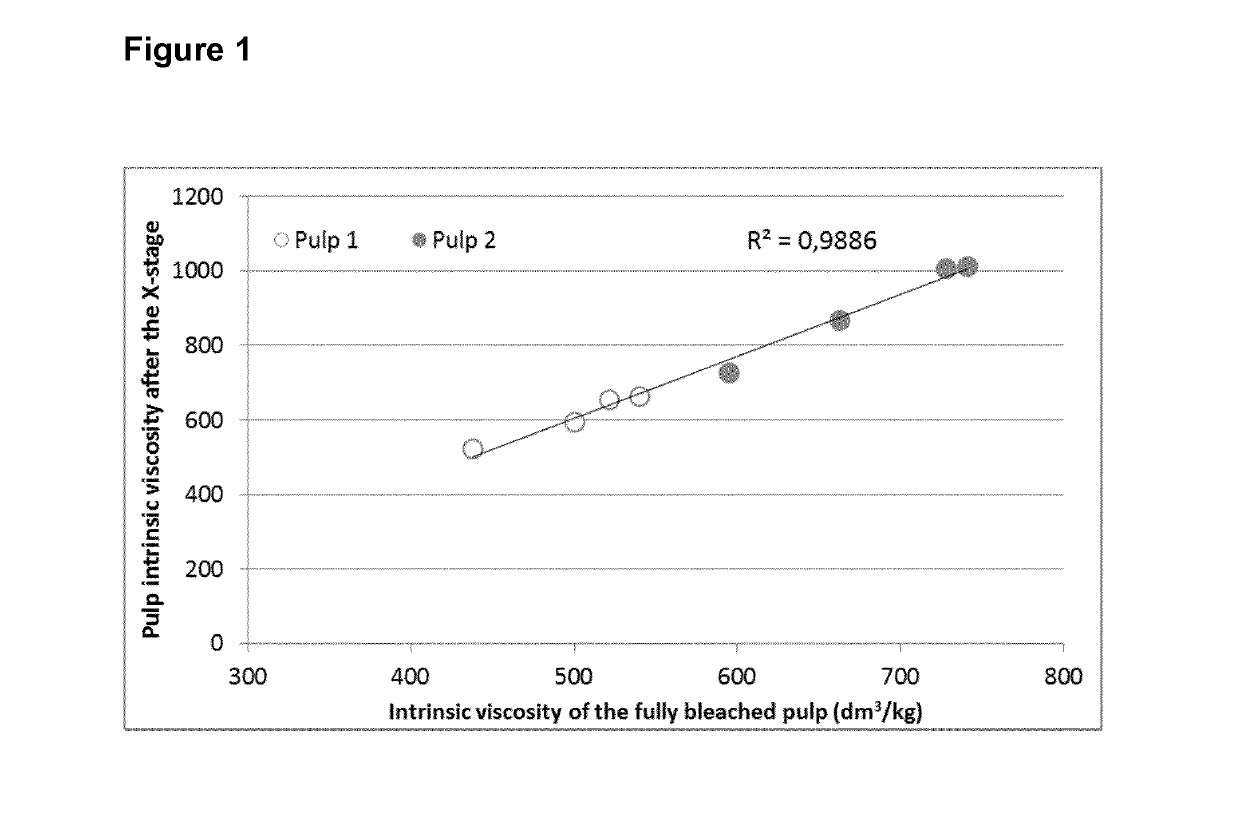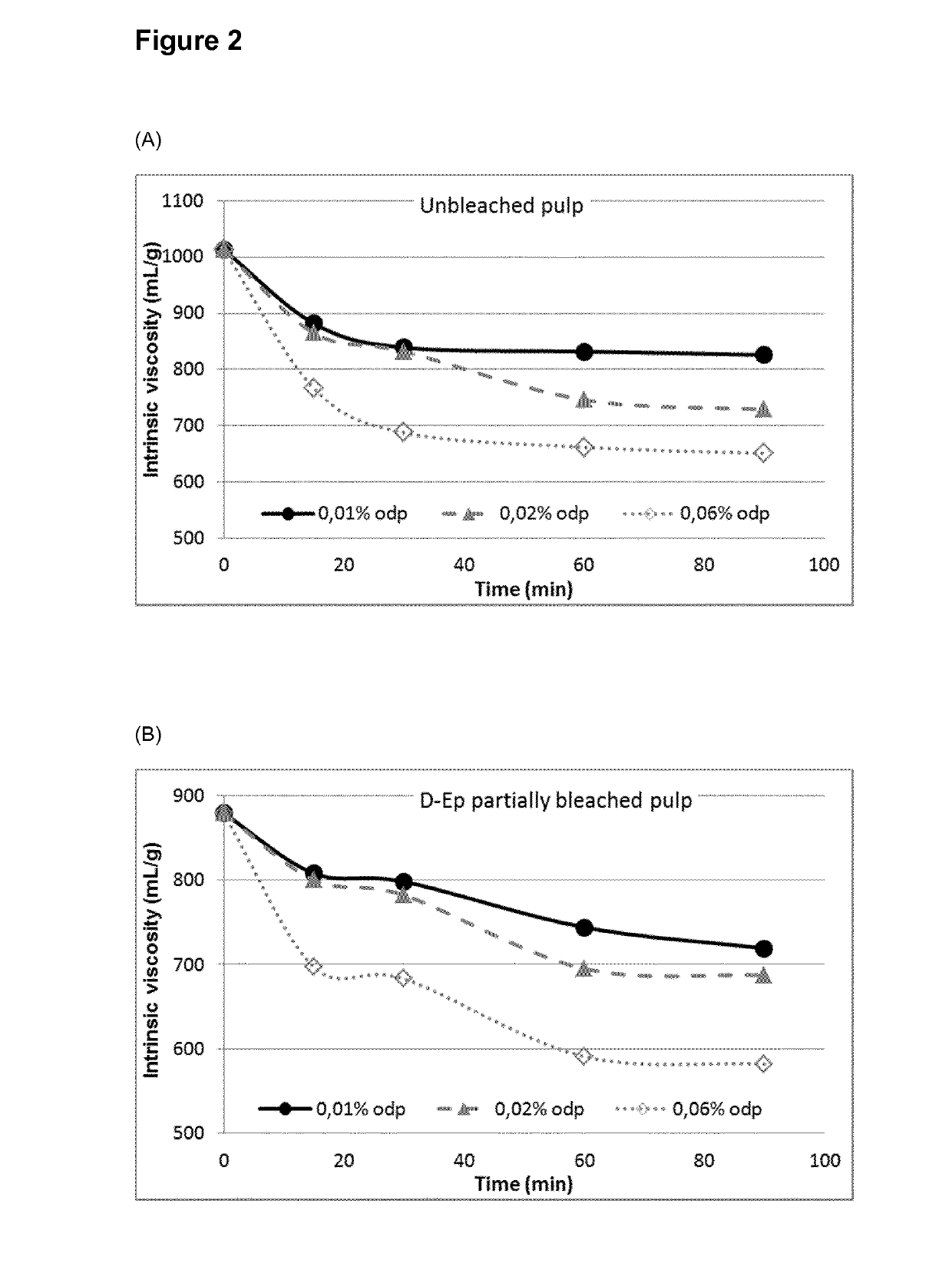Use of Cellulase to improve Viscosity Control of Dissolving Pulp
a technology of cellulase and dissolving pulp, which is applied in the direction of continuous pulping process, cellulose treatment using microorganisms/enzymes, inorganic base pulping, etc., to achieve uniform molecular weight distribution, high cellulose content, and high brightness
- Summary
- Abstract
- Description
- Claims
- Application Information
AI Technical Summary
Benefits of technology
Problems solved by technology
Method used
Image
Examples
example 1
Treatment of Unbleached Hardwood Kraft Pulp
[0085]Two unbleached hardwood kraft dissolving pulps produced by a pre-hydrolysis kraft (PHK) pulping process were used and treated in an enzymatic-stage denoted as X-stage. Typically, 15 g of oven-dry fiber was treated with enzymes at medium pulp consistency of 10% at a temperature of 60° C., pH 5.5 (acetate buffer) for “pulp 1” or pH 8.0 (phosphate buffer) for “pulp 2” and for 90 min. The enzyme dosage was 0.050% odp of xylanase product from Bacillus agaradhaerens (SEQ ID NO: 4) and 0.025% odp of cellulase A product from Humicola insolens (SEQ ID NO: 2) and cellulase B product from Paenibacillus polymyxa (SEQ ID NO: 3).
[0086]The pulp suspension was incubated in polyethylene sealed plastic bags immersed in a temperature controlled water bath. After incubation, the pulp was washed and filtered with 2 L of warm tap water divided in two steps and 1 L of deionized water.
[0087]The intrinsic viscosity results of the produced pulps are presented ...
example 2
ching of the Enzyme Treated Hardwood Pulps and Determination of Final Intrinsic Viscosity and ISO Brightness
[0088]The hardwood kraft pulps produced in Example 1 were further treated by D-Ep-D-P bleaching sequence. The first D-stage was carried out at an initial pH of 3.5 and at 60° C. for 1 h using 0.25% (pulp 1) or 0.75% (pulp 2) odp ClO2 while the second D-stage was at an initial pH of 4.0 and at ca. 75° C. for 1.8 h and 0.16% (pulp 1) or 0.32% (pulp 2) odp of ClO2. The Ep stage was carried out at an initial pH 11 and using 0.15% odp of H2O2 and 0.10% odp of MgSO4 at ca. 75° C. for 1.4 h. As for the final P stage, the initial pH was 11 and 0.30% odp of H2O2 and 0.10% odp of MgSO4 at ca. 80° C. for 1.4 h. All stages were done at 10% pulp consistency in polyethylene sealed plastic bags immersed in a temperature controlled water bath. After each stage, the pulp was washed and filtered as described in Example 1.
[0089]In Table 2 is presented the intrinsic viscosity and ISO brightness o...
example 3
on Between the Pulp Viscosity Obtained after the Enzyme Treatment Done to the Unbleached Hardwood Pulp and the Final Viscosity of the X-D-Ep-D-P Fully Bleached Pulp
[0090]As seen in FIG. 1, there is a noteworthy linear correlation between the pulp viscosity after the X-stage done in the beginning of the bleaching sequence as measured in Example 1 and the final viscosity of the fully bleached pulp as measured in Example 2. This reveals that the drop in pulp viscosity made by the cellulase in pre-bleaching is stable along the whole bleaching sequence and thus allowing higher flexibility with regard to the application point of the cellulase for the control of pulp viscosity and possibly increase of pulp reactivity. Although the extent of viscosity reduction between both pulps is different, it is quite surprising to find in FIG. 1 the same linearity for the two pulps which had originally different intrinsic viscosities and were treated at different pH (5.5 vs. 8.0) in the enzyme stage (X...
PUM
| Property | Measurement | Unit |
|---|---|---|
| temperatures | aaaaa | aaaaa |
| pH | aaaaa | aaaaa |
| pH | aaaaa | aaaaa |
Abstract
Description
Claims
Application Information
 Login to View More
Login to View More - R&D
- Intellectual Property
- Life Sciences
- Materials
- Tech Scout
- Unparalleled Data Quality
- Higher Quality Content
- 60% Fewer Hallucinations
Browse by: Latest US Patents, China's latest patents, Technical Efficacy Thesaurus, Application Domain, Technology Topic, Popular Technical Reports.
© 2025 PatSnap. All rights reserved.Legal|Privacy policy|Modern Slavery Act Transparency Statement|Sitemap|About US| Contact US: help@patsnap.com


